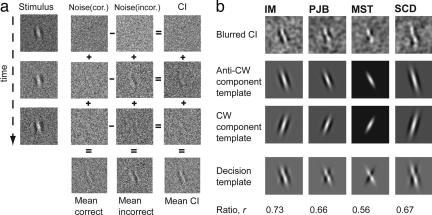Fig. 1.
CI technique and fitting procedure. (a) Subjects reported whether a Gabor target, continuously present within 32 frames of dynamic white noise, was tilted clockwise or anticlockwise of vertical. Noise frames were stored according to the observers' response into the “correct” (center left column) or “incorrect” (center right column) category. The 32 single frame CIs obtained at the end of 10,000 trials (rightmost column) were obtained from the difference between incorrect and correct CIs. Mean CIs for the correct-incorrect categories can be obtained by averaging the corresponding columns. (b) Fitting procedure. Because observers are performing a discrimination task, the optimal template for performing this task is the difference between the two possible targets. Consequently, CI data were fit (having first been spatially blurred) with a weighted difference of two component templates (Gabors, one the mirror image of the other). Fits had six parameters, five for the components and one for their weighting. The component-pairs are illustrated in the two rows below the blurred CIs. The decision templates are the differences of the component templates weighted by the r value given below. Note that fitted decision templates account well for the appearance of the CIs including the checkered appearance of the template for M.S.T. Most of the decision templates were dominated by a single component indicating that some observers' performance was limited by their ability to detect the target rather than tell what orientation it was (see Supporting Text and Fig. 4 for details).

